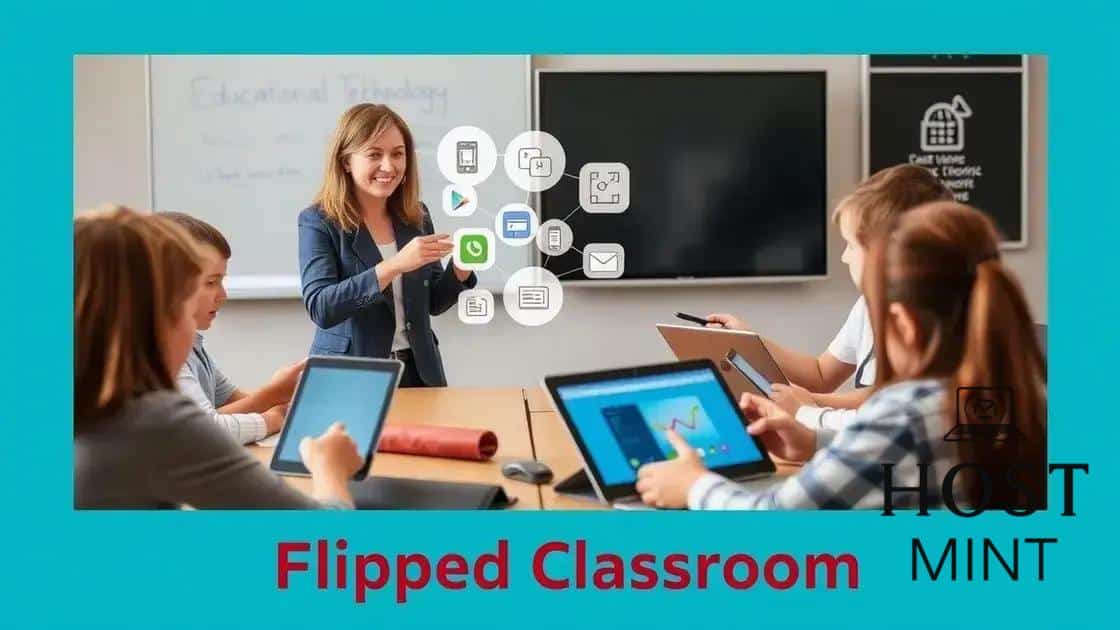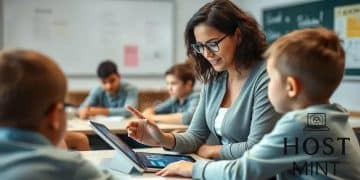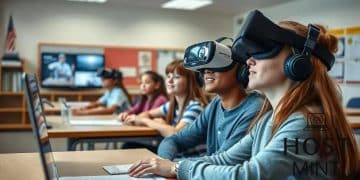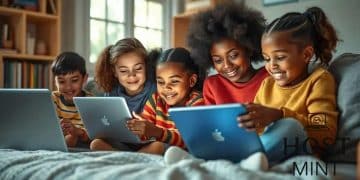Flipped classrooms: Is this learning model here to stay?

The flipped classroom model shifts traditional learning by having students engage with lectures at home and participate in interactive activities during class, enhancing engagement and personalized learning.
Flipped classrooms have sparked conversations in education about their effectiveness and longevity. But what exactly does this model entail, and how might it impact learning? Let’s dive into this transformative approach and explore its implications.
Understanding the flipped classroom model
The flipped classroom model is gaining popularity in educational settings. Unlike traditional classrooms, where teachers deliver lectures in person, this innovative approach reverses the learning process. Students watch lectures at home, freeing up class time for engaging activities. This shift allows for more interactive learning experiences.
Key Features of the Flipped Classroom
In a flipped classroom, students use various resources at home, such as video lectures, podcasts, and reading materials. They come to class prepared to discuss and apply what they’ve learned. This method promotes deeper understanding and critical thinking.
- Students learn at their own pace, allowing for personalized education.
- Class time focuses on collaboration and hands-on work.
- Teachers act as facilitators, providing guidance and support.
- Assessment and feedback happen in real-time during class activities.
The benefits of this model are numerous. Students can revisit complex material at their convenience, and they often take a more active role in their education. In fact, many educators report increased student engagement and motivation. By providing access to technology, teachers can help students develop essential digital skills while enhancing their learning experience.
Challenges in Implementation
While the flipped classroom model has many advantages, it also presents challenges. Not all students have equal access to technology, creating disparities in learning opportunities. Teachers must also be prepared to change their teaching styles and adapt their lesson plans.
Another consideration is ensuring students stay accountable for their at-home learning. Clear communication and structured guidance are key to successful implementation. By addressing these challenges, educators can create a more inclusive and effective learning environment.
Benefits for students and teachers
The flipped classroom model offers several benefits that positively impact both students and teachers. One of the key advantages is that it promotes active learning. Students engage in discussions and group work during class time, allowing for collaborative problem-solving.
Enhanced Engagement
When students watch lectures at home, they come prepared to participate. This leads to a more dynamic classroom atmosphere. Teachers can facilitate discussions and guide students through hands-on learning experiences. Students find this environment more engaging than passive note-taking.
- Encourages student participation in class activities.
- Fosters a sense of community among learners.
- Allows for diverse learning styles to be accommodated.
Another benefit is the flexibility it provides. Students can learn at their own pace, reviewing content they find challenging. This is particularly helpful for students who may struggle with certain concepts. Teachers can easily track which students need extra help, allowing for targeted support.
Improved Teacher-Student Interaction
With more time available in the classroom, teachers have the opportunity to connect with students on a personal level. They can identify individual challenges and adapt their teaching methods accordingly. This personalized approach can significantly enhance the learning experience.
Additionally, teachers can design assessments that focus on applying knowledge rather than rote memorization. This shift in evaluation makes learning more meaningful for students. They learn to think critically and to apply their knowledge in real-world scenarios, which is a crucial skill.
Challenges faced by the flipped classroom
While the flipped classroom model offers many advantages, it also presents several challenges. One significant issue is the unequal access to technology. Not every student has reliable internet or devices at home, which can hinder their ability to engage with at-home learning resources.
Teacher Training and Support
Another challenge in implementing this model is the need for proper teacher training. Educators must learn how to design effective flipped lessons and utilize technology properly. Without sufficient support, teachers may struggle to adapt their teaching styles.
- Professional development is crucial for successful implementation.
- Collaboration among staff can enhance the learning experience.
- Ongoing support helps teachers navigate new challenges.
Additionally, managing classroom dynamics can be tricky when using the flipped classroom model. Students may come to class with varying levels of understanding, making it challenging for teachers to address everyone’s needs. This variance can lead to frustration for both students and educators.
Maintaining Student Accountability
Another concern involves ensuring that students complete their at-home learning assignments. Without accountability, some students might skip these tasks, making class time less effective. Educators need to find ways to motivate students to engage with the materials at home.
Finally, balancing instruction between online and classroom activities can also be difficult. Teachers often need to rethink their lesson plans to ensure they align with the flipped model. This requires creativity and flexibility, skills that not all educators may possess right away.
Technological tools for effective implementation

The successful implementation of the flipped classroom model heavily relies on technological tools. These tools enhance the learning experience and make it easier for both teachers and students to adapt to this innovative approach. Various platforms and applications can support blended learning, creating engaging content for all.
Video Creation Tools
Creating high-quality videos is crucial for the flipped classroom. Teachers can use tools like Edpuzzle and WeVideo to make interactive lessons. These platforms allow educators to edit videos, add quizzes, and track student engagement, making the learning process more engaging.
- Edpuzzle allows embedding questions within videos to assess understanding.
- WeVideo provides user-friendly editing features for visually appealing content.
- Both platforms enable teachers to monitor student progress effectively.
Another essential aspect is the use of learning management systems (LMS). Platforms like Google Classroom and Moodle facilitate organization and communication. They provide a space for posting assignments, sharing resources, and fostering collaboration.
Collaboration and Communication Tools
Collaboration tools are equally important in a flipped classroom. Using applications like Slack or Microsoft Teams, students can discuss assignments and work on projects together. These platforms promote teamwork and communication outside of school hours.
Moreover, incorporating quiz tools such as Kahoot! and Quizizz can enhance student engagement. These platforms offer fun and interactive ways to review and assess knowledge, helping students stay motivated.
In conclusion, leveraging the appropriate technological tools can significantly benefit the implementation of the flipped classroom model. By using video creation tools, learning management systems, and collaboration platforms, educators can create a more effective and engaging learning environment for their students.
Future trends in flipped classrooms
As education evolves, the flipped classroom model is also changing. Future trends suggest a deeper integration of technology and personalized learning. This model will continue to adapt to meet the needs of diverse learners in the digital age.
Increased Use of Artificial Intelligence
One notable trend is the use of artificial intelligence in education. AI can help teachers personalize learning experiences for students based on their performance. For instance, AI-driven platforms may analyze student data to suggest tailored content or study resources, enhancing the flipped classroom experience.
- AI can provide instant feedback to students on their work.
- It can offer customized learning paths for individual learners.
- AI tools can assist teachers in identifying students who may need extra help.
Another trend is the rise of immersive technologies. Virtual reality (VR) and augmented reality (AR) will play a significant role in the flipped classroom. These technologies can create engaging learning environments that allow students to explore complex topics in ways that traditional methods cannot.
Focus on Social Emotional Learning
Alongside technological advancements, there will be an increased focus on social-emotional learning (SEL). Educators will prioritize developing students’ emotional intelligence and resilience. As part of this trend, flipped classrooms may include activities that support SEL, promoting collaboration and communication among peers.
More collaboration tools will likely emerge, encouraging stronger connections among students. This approach allows learners to engage deeply with their peers and their instructor, resulting in better understanding and retention of knowledge. Through this collaboration, classrooms will evolve into supportive learning communities.
Ultimately, the future of flipped classrooms will trend towards a more holistic approach. By combining technology with emotional and social support, educators can create enriching and inclusive learning experiences that cater to every student’s needs.
The flipped classroom model represents a significant shift in how education is delivered. By placing students at the center of their learning, this approach encourages engagement and collaboration. With advancements in technology and a focus on social-emotional learning, the flipped classroom is set to reshape education in the future. Preparing educators and students for these changes will be essential for maximizing its benefits.
FAQ – Frequently Asked Questions about Flipped Classrooms
What is a flipped classroom?
A flipped classroom is an instructional strategy where traditional learning elements are reversed. Students learn content at home through videos and then practice or apply what they’ve learned in class.
What are the main benefits of a flipped classroom?
The benefits include increased student engagement, personalized learning experiences, and more opportunities for collaboration and interaction during class time.
What challenges do teachers face when implementing a flipped classroom?
Challenges include ensuring all students have access to technology, needing proper training for educators, and maintaining student accountability for at-home learning.
How can technology enhance the flipped classroom experience?
Technology tools like video creation software, learning management systems, and collaboration platforms help streamline the learning process and improve student engagement.






